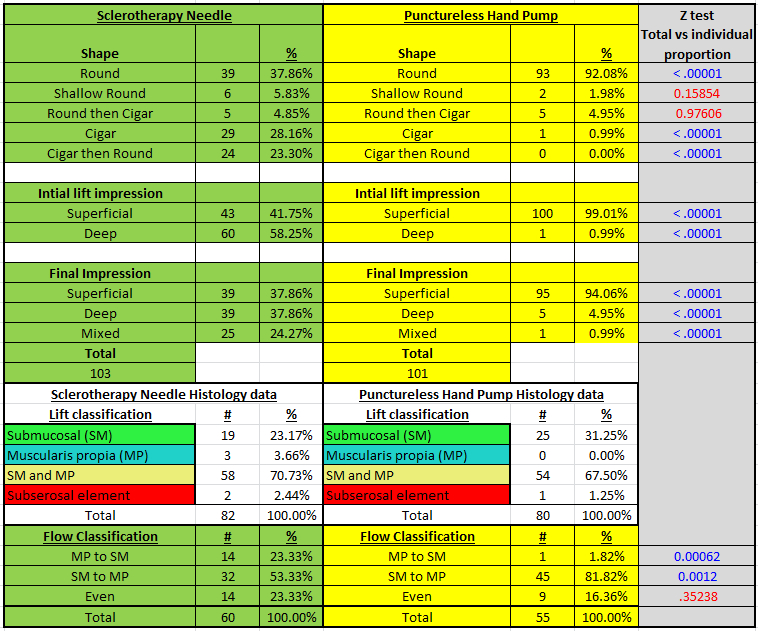ECONOMICAL NEEDLELESS AND PUNCTURELESS HIGH PRESSURE ENDOSCOPIC LIFT ESTABLISHMENT METHOD FOR ESD MORE RELIABLY EXPANDS THE SUBMUCOSAL LAYER VS. THE STANDARD SCLEROTHERAPY NEEDLE/CATHETER IN AN EX VIVO BOVINE COLON MODEL.
Neil Mitra*1, Dasuni Niyagama Gamage1, Abdelsalam Sharabi2, Carl S. Winkler1, Jaspreet Sandhu4, Xiaohong Yan1, Vesna Cekic1, Hiromichi Miyagaki3, Shantha Kumara HMC1, Richard L. Whelan1
1Surgery, Mount Sinai West Hospital, New York, NY; 2Pathology, Mount Sinai West Hospital, New York, NY; 3Surgery, Saiseikai Senri Hospital, Osaka, Japan; 4Surgery, Brookdale Hospital Medical Center, Brooklyn, NY
Introduction: Generating a mucosal lift is critical for Endoscopic Submucosal Dissection (ESD). The expanded submucosa(SM) provides a working space for polyp detachment. The sclerotherapy catheter/needle (SN) is the most commonly used and economical lift generating method. Because a hard needle push is needed to penetrate the mucosa, the tip most often ends up in the muscularis propria (MP) or beyond. While injecting, the needle is withdrawn until the SM expands (round and sharp elevation); then the needle is held still and the lift completed. It has been shown that inadvertent stable deep wall lifts may develop (expansion of subserosal or MP layers) and that double lifts also occur. ESD is not feasible with a deep lift. It can be difficult to distinguish superficial and deep wall lifts. The alternative lift generation method is a machine driven high pressure needleless system that is usually housed in a needle knife. The avoidance of a puncture makes deep lifts unlikely. This system is expensive, and thus, is not widely used. This study assesses the lift generating capacity of an economical needleless/punctureless standalone catheter that is driven by a reusable hand pump (HP) and compares it to the SN.
Methods: Harvested intact ex vivo bovine colon/rectum/anus was used for this study. Colons were cleaned, instilled with antibiotics and refrigerated until use. Saline with dye was injected; lifts were generated via the HP and SN methods (12-18 lifts/method/colon). Videos and pictures of the pelts (post opening) were made. The lifts were visually inspected and the following parameters tracked: 1) lift shape (transverse oval/cigar shape [ie. deep lifts] vs round/sharp [SM]), 2) the initial and 3) final lift type impression. The lifts were also histologically assessed.
Results: Six bovine colons were used and 103 SN and 101 HP lifts generated. 92% of the HP lifts were round and sharp vs 38% with the SN (P value=<.01). The initial impression was SM lift in 99% of HP vs 42 % of SN lifts (P value=<.01). The final impression was of a mixed lift (both muscle and submucosa) in 6% HP and 24% SN (P value=<.01). Histologically, pure SM were noted in 31% HP vs 23% SN. Mixed lifts were most often noted in both groups (likely due to ex vivo colon's poor tissue integrity); it was judged (via dye distribution and penetrance pattern) that the SM layer expanded initially in 82 % of HP vs 53% of SN lifts (P value=<.01).
Conclusion: Based on shape and lift qualities the HP method was more likely to generate a superficial lift (vs SN). The histological results show that with dead tissue it is difficult to make pure SM lifts, likely, because of poor tissue integrity. However, the data suggests the HP method is more likely to initially expand the SM space. The HP method may be preferable to SN for lift generation. Further study is needed.

Back to 2019 Posters




